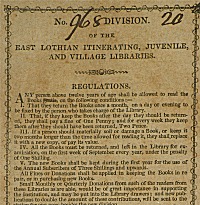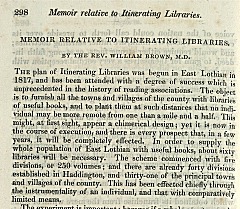Contents ![]() | Introduction
| Introduction ![]() | Institutes of learning
| Institutes of learning ![]()

Itinerating libraries
Page 2 of 2 | Back
As well as providing a short account of library regulations, Samuel Brown's care for both books and learning is evident in the 'hints' he provided for library users. Readers were encouraged to 'read regularly through', 'with a desire to be instructed', it being 'better to read little and profit' than to 'hurry over'.

Brown and his supporters also tried to interest others in the scheme. His sons John Croumbie Brown (1808-1895, Minister in St Petersburg, Cape Town, and Scotland; later professor of botany, South African College) and Samuel Brown II (1817-1856, chemist, graduate Haddington School of Arts and Edinburgh University, friend of Samuel Smiles) were particularly active, using their contacts wherever possible.
A few libraries circulated in Midlothian and some went to South Africa through John Croumbie Brown's missionary contacts. Others were attempted in the Scottish Borders. However, only the East Lothian scheme worked well and it began to decline after Samuel Brown's death. It declined when dedicated and enthusiastic replacement librarians could not be found. But, by the second half of the nineteenth century, there were in any case more public and subscription libraries to cater to the demand for books. Nonetheless, the whole experiment was of lasting importance. The philosophy underlying it is at the core of the county and city library services of the present day.
Page 2 of 2 | Back
In this section:
Circulating libraries | Subscription libraries | Itinerating libraries | Free public libraries
Contents ![]() | Introduction
| Introduction ![]() | Institutes of learning
| Institutes of learning ![]()